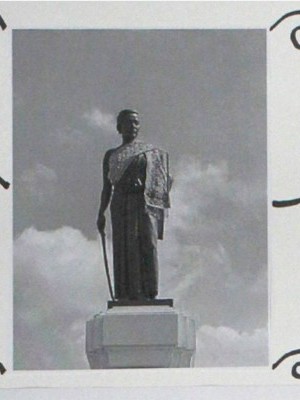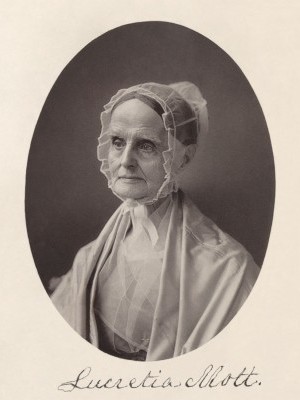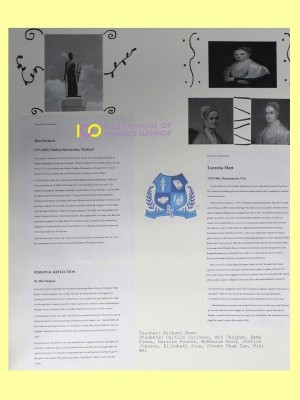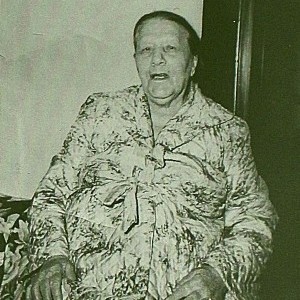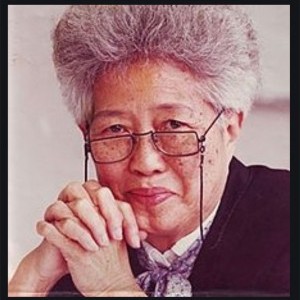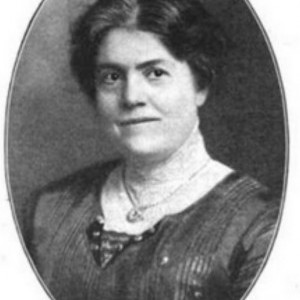Min Chaipun
Rainier Christian High School | Auburn, WA | 12th Grade
A Feminist from Thailand
Thao Suranari
Thao Suranari, Lady Mo, or Ya Mo (Grandma Mo), was the wife of the Deputy Governor of Nakhon Ratchasima (Korat), the stronghold of Siamese control over its Laotian vassals. She was born in 1771 at the Southern part of Korat (Nakhon Ratchasima). At the age of 25, she married
Nai Tong Kao who would later become a Deputy Governor of Korat.
In 1826 King Anouvong, ruler of the Lao kingdom of Vientiane, invaded Siam seeking complete independence. Anouvong’s forces seized the city of Nakhon Ratchasima by a ruse when the governor was away. The invaders evacuated the inhabitants, intending to resettle them in Laos.
Lady Mo is credited with saving her people by harassing the enemy. Varying stories describe her either getting the invading soldiers drunk, or leading a rebellion of the prisoners on the way back to Vientiane. The generally accepted version is that, when the Lao invaders ordered the women to cook for them, Lady Mo requested knives so that food might be prepared. That night, when the invaders were asleep, she gave the knives to the imprisoned men. They surprised the Lao troops who fled and the prisoners escaped. Thai King Rama III soon sent an army in pursuit, led by General Sing Singhaseni. He defeated Anouvong’s forces in three days of fighting and completely destroyed Anouvong’s capital city of Vientiane.
Lady Mo saved many Thai women who were harassed by Lao invaders, and this is why she is recognized as one of the most significant figure of Thailand feminism.
Historical Figure I Admire
Lucretia Mott
Lucretia Mott was a US Quaker, an abolitionist, a women’s rights activist, and a social reformer. She is known for standing against the racial and gender injustices of her time and for co-founding the American Anti-Slavery Society.
Mott was born on January 3, 1793, on Nantucket Island, in Massachusetts. She was the second child of Thomas Coffin, Jr. and Anna Folger Mott. Her family was Quaker, therefore she was sent to a Quaker boarding school in Upstate New York. In 1811, she married her father’s business partner, James Mott, who became one of her greatest supporter in the future. As she was a Quaker, she considered slavery to be evil. So, she became a member of Frank Lloyd Garrison’s American Anti-Slavery Society in 1833 and with her husband became an organizer of the Philadelphia Female Anti-Slavery Society. At that time, many people opposed women speaking in public, so Mott was criticized for acting inappropriately as a woman. But, that wouldn’t destroy Mott’s strong will. In 1840, Mott attended the World’s Anti-Slavery Convention where she met an activist Elizabeth Stanton. In that event, she had to sit in the segregated area even though that many people protested for her in that event. After the event, she came back to America and started to give more public lectures against slavery.
Mott was involved in so many aspects of women’s rights. In 1848, Mott and Cady Stanton organized the Seneca Falls Convention, the first women’s rights convention, at Seneca Falls, New York. Initially, Mott disagreed with Stanton’s resolution that “ it was the duty of the women of this country to secure for themselves the sacred right to the elective franchise” because she viewed politics as corrupted by slavery. But eventually, she agreed to sign the Declaration of Sentiments. Mott was elected to be the first president of the American Equal Rights Association, but she later resigned since the association allied with George Francis Train.
Although Stanton was pretty much credited for those women’s rights movements. Mott was the one who made those events happen. In 1850, Mott published her speech Discourse on Woman, a pamphlet about restrictions on women in the United States. She remained active and fought for women’s rights until her death in 1880.
What the Project Means to Me
Inequality between people has been the most concerning problem in the the history of mankind. Many people would get segregated in so many ways for being different or belonging to the female class. However, I’ve learned that countless people came up to fight for their rights even though the majority would be strongly against them. Moreover, those people had gone through numerous hardships for the rest of their people to become equal with the majority.
I’ve learned that women were really looked down upon by men back in the days. However, because of various movements, women gained status and became socially equal to men. I can absolutely tell that it must be very tough for them to not be able to vote like other people. It felt like they were alienated. Though they were looked down upon, many women came out and showed that we’re all equal.
Doing this project has shown me so many beautiful sides of people coming out and fighting for their rights.
Explore the Archive
More From This Class
Click on the thumbnails below to view each student's work.Deadline Extended
There's still time to join Women Leading the Way.
Become a part of our storytelling archive. Enroll your class today.
Join the Project

